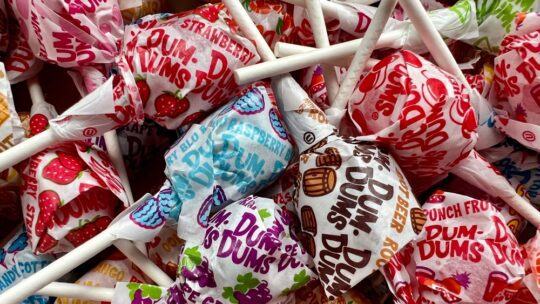
12 million suckers can’t be wrong… or can they? Spangler Candy Company, parent company and maker of beloved lollipops Dum-Dums, in May doubled down on its use of artificial dyes in the colorful, flavorful confections.
As U.S. Secretary of Health and Human Services Robert F. Kennedy, Jr. continues his mission to eliminate artificial dyes from food, many food companies (most recently General Mills, as well as Kraft Heinz, McCormick Spices and snack food maker Mondelez) have already taken proactive steps to begin changing their ingredients and incorporating natural dyes into their products. These changes, seemingly swift and without great pushback, have been met with early positive feedback from the administration and consumers alike.
Even so, it’s likely easier in some food products than others to incorporate natural products as coloration mechanisms. And when you’re a product that relies on color as a defining feature of the brand (think, light red for watermelon; deep red for cherry; bright green apple, etc.), slow rolling any ingredient changes seems understandable—but it’s not without risk.
Any brand that chooses to take (and promote) a public stand should prepare for what’s next, including thoughtfully identifying the land mines ahead and being ready to respond to potential risks. As Spangler establishes their lane on the issue of food dyes, the possible threats to Spangler’s reputation include:
- Backlash from Political Leaders – In recent years, elected and appointed officials from all sides have been more inclined to call out those companies who publicly decry their decision-making. It seems likely that this iconic product could become an easy and specific target for political leaders to use as a symbol of the fight against artificial food dyes.
- Consumer Pressure – At the heart of it, Dum-Dums are a product for children (although what adult hasn’t picked up a lollipop from a bowl on occasion and enjoyed it immensely?). Many moms’ advocacy groups have already raised public concerns about artificial food dyes—and have celebrated brands that have moved to remove them. For example, the page “Dye-Free Kids” on Facebook has more than 230,000 followers and is actively engaged on this topic.
- Media Mobilization – Senior leaders from the current administration have consistently demonstrated their ability to mobilize online and broadcast media outlets and their audiences to make their cases. Expect specific callouts of brands that refuse to align with the HHS initiatives, especially when the symbol is a beloved product with a long history.
- Social Media Activations – Political leaders have consistently leveraged their large and engaged social media followings to call out companies of all sizes—posts that are swiftly reshared and amplified across followers and networks.
While most of the proposals around eliminating artificial food dyes don’t call for implementation for more than a year, many companies that rely on artificial color, including Spangler, have signaled they will continue to evaluate possible switches to natural dyes.
Even so, Spangler CEO Kirk Vashaw has held firm on the company’s use of synthetic dyes, citing challenges with maintaining the candy’s flavor profile and concerns about consumer acceptance. The company shared it once offered a natural ingredient sucker, and it was discontinued due to poor sales. Vashaw indicates he will wait for clarity and the regulatory guidance before the company will reformulate its ingredients.
When companies like Spangler take a stand on food (or other) issues, especially in the context of the current administration’s fast-moving policymaking, being prepared and planning for how to respond to key stakeholders is essential. Brands should start with:
- Understanding key audiences and where they are on the issue at hand, whether it is customers, consumers, shareholders or employees;
- Developing a strategy and messages that aligns with stakeholder beliefs and values, and builds trust;
- Provides specific reassurance to those most likely to be impacted by the public narrative—including customers and consumers;
- Establishing a strong issues and crisis readiness plan that anticipates risks and responds to threats;
- Carefully monitoring sentiment and coverage as the issue evolves; and
- Pivoting the strategy as necessary to maintain a firm reputational position.
Ultimately, being prepared when taking a stand is just good business, and for brands, it’s the best protection against being sucker-punched.
Hinda Mitchell is President of Inspire PR Group.
